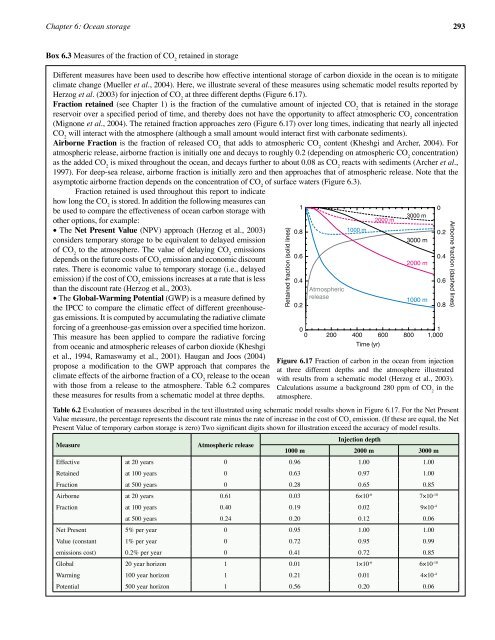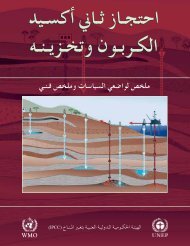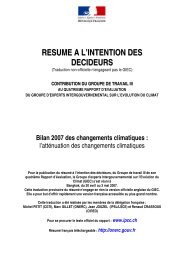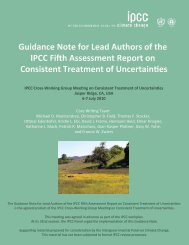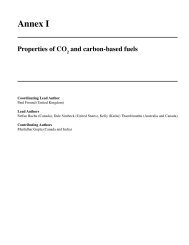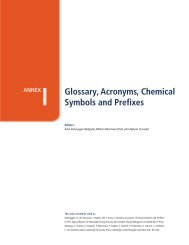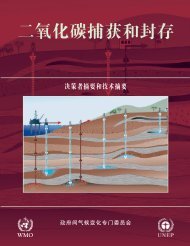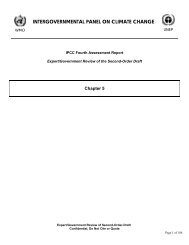Intergovernmental Panel on Climate Change (IPCC ... - ipcc-wg3
Intergovernmental Panel on Climate Change (IPCC ... - ipcc-wg3
Intergovernmental Panel on Climate Change (IPCC ... - ipcc-wg3
Create successful ePaper yourself
Turn your PDF publications into a flip-book with our unique Google optimized e-Paper software.
Chapter 6: Ocean storage 293<br />
Box 6.3 Measures of the fracti<strong>on</strong> of CO 2<br />
retained in storage<br />
Different measures have been used to describe how effective intenti<strong>on</strong>al storage of carb<strong>on</strong> dioxide in the ocean is to mitigate<br />
climate change (Mueller et al., 2004). Here, we illustrate several of these measures using schematic model results reported by<br />
Herzog et al. (2003) for injecti<strong>on</strong> of CO 2<br />
at three different depths (Figure 6.17).<br />
Fracti<strong>on</strong> retained (see Chapter 1) is the fracti<strong>on</strong> of the cumulative amount of injected CO 2<br />
that is retained in the storage<br />
reservoir over a specified period of time, and thereby does not have the opportunity to affect atmospheric CO 2<br />
c<strong>on</strong>centrati<strong>on</strong><br />
(Mign<strong>on</strong>e et al., 2004). The retained fracti<strong>on</strong> approaches zero (Figure 6.17) over l<strong>on</strong>g times, indicating that nearly all injected<br />
CO 2<br />
will interact with the atmosphere (although a small amount would interact first with carb<strong>on</strong>ate sediments).<br />
Airborne Fracti<strong>on</strong> is the fracti<strong>on</strong> of released CO 2<br />
that adds to atmospheric CO 2<br />
c<strong>on</strong>tent (Kheshgi and Archer, 2004). For<br />
atmospheric release, airborne fracti<strong>on</strong> is initially <strong>on</strong>e and decays to roughly 0.2 (depending <strong>on</strong> atmospheric CO 2<br />
c<strong>on</strong>centrati<strong>on</strong>)<br />
as the added CO 2<br />
is mixed throughout the ocean, and decays further to about 0.08 as CO 2<br />
reacts with sediments (Archer et al.,<br />
1997). For deep-sea release, airborne fracti<strong>on</strong> is initially zero and then approaches that of atmospheric release. Note that the<br />
asymptotic airborne fracti<strong>on</strong> depends <strong>on</strong> the c<strong>on</strong>centrati<strong>on</strong> of CO 2<br />
of surface waters (Figure 6.3).<br />
Fracti<strong>on</strong> retained is used throughout this report to indicate<br />
how l<strong>on</strong>g the CO 2<br />
is stored. In additi<strong>on</strong> the following measures can<br />
be used to compare the effectiveness of ocean carb<strong>on</strong> storage with<br />
other opti<strong>on</strong>s, for example:<br />
• The Net Present Value (NPV) approach (Herzog et al., 2003)<br />
c<strong>on</strong>siders temporary storage to be equivalent to delayed emissi<strong>on</strong><br />
of CO 2<br />
to the atmosphere. The value of delaying CO 2<br />
emissi<strong>on</strong>s<br />
depends <strong>on</strong> the future costs of CO 2<br />
emissi<strong>on</strong> and ec<strong>on</strong>omic discount<br />
rates. There is ec<strong>on</strong>omic value to temporary storage (i.e., delayed<br />
emissi<strong>on</strong>) if the cost of CO 2<br />
emissi<strong>on</strong>s increases at a rate that is less<br />
than the discount rate (Herzog et al., 2003).<br />
• The Global-Warming Potential (GWP) is a measure defined by<br />
the <strong>IPCC</strong> to compare the climatic effect of different greenhousegas<br />
emissi<strong>on</strong>s. It is computed by accumulating the radiative climate<br />
forcing of a greenhouse-gas emissi<strong>on</strong> over a specified time horiz<strong>on</strong>.<br />
This measure has been applied to compare the radiative forcing<br />
from oceanic and atmospheric releases of carb<strong>on</strong> dioxide (Kheshgi<br />
et al., 1994, Ramaswamy et al., 2001). Haugan and Joos (2004)<br />
propose a modificati<strong>on</strong> to the GWP approach that compares the<br />
climate effects of the airborne fracti<strong>on</strong> of a CO 2<br />
release to the ocean<br />
with those from a release to the atmosphere. Table 6.2 compares<br />
these measures for results from a schematic model at three depths.<br />
Figure 6.17 Fracti<strong>on</strong> of carb<strong>on</strong> in the ocean from injecti<strong>on</strong><br />
at three different depths and the atmosphere illustrated<br />
with results from a schematic model (Herzog et al., 2003).<br />
Calculati<strong>on</strong>s assume a background 280 ppm of CO 2<br />
in the<br />
atmosphere.<br />
Table 6.2 Evaluati<strong>on</strong> of measures described in the text illustrated using schematic model results shown in Figure 6.17. For the Net Present<br />
Value measure, the percentage represents the discount rate minus the rate of increase in the cost of CO 2<br />
emissi<strong>on</strong>. (If these are equal, the Net<br />
Present Value of temporary carb<strong>on</strong> storage is zero) Two significant digits shown for illustrati<strong>on</strong> exceed the accuracy of model results.<br />
Measure<br />
Atmospheric release<br />
Injecti<strong>on</strong> depth<br />
1000 m 2000 m 3000 m<br />
Effective at 20 years 0 0.96 1.00 1.00<br />
Retained at 100 years 0 0.63 0.97 1.00<br />
Fracti<strong>on</strong> at 500 years 0 0.28 0.65 0.85<br />
Airborne at 20 years 0.61 0.03 6×10 -6 7×10 -10<br />
Fracti<strong>on</strong> at 100 years 0.40 0.19 0.02 9×10 -4<br />
at 500 years 0.24 0.20 0.12 0.06<br />
Net Present 5% per year 0 0.95 1.00 1.00<br />
Value (c<strong>on</strong>stant 1% per year 0 0.72 0.95 0.99<br />
emissi<strong>on</strong>s cost) 0.2% per year 0 0.41 0.72 0.85<br />
Global 20 year horiz<strong>on</strong> 1 0.01 1×10 -6 6×10 -10<br />
Warming 100 year horiz<strong>on</strong> 1 0.21 0.01 4×10 -4<br />
Potential 500 year horiz<strong>on</strong> 1 0.56 0.20 0.06


